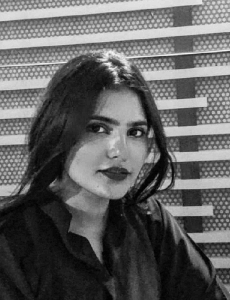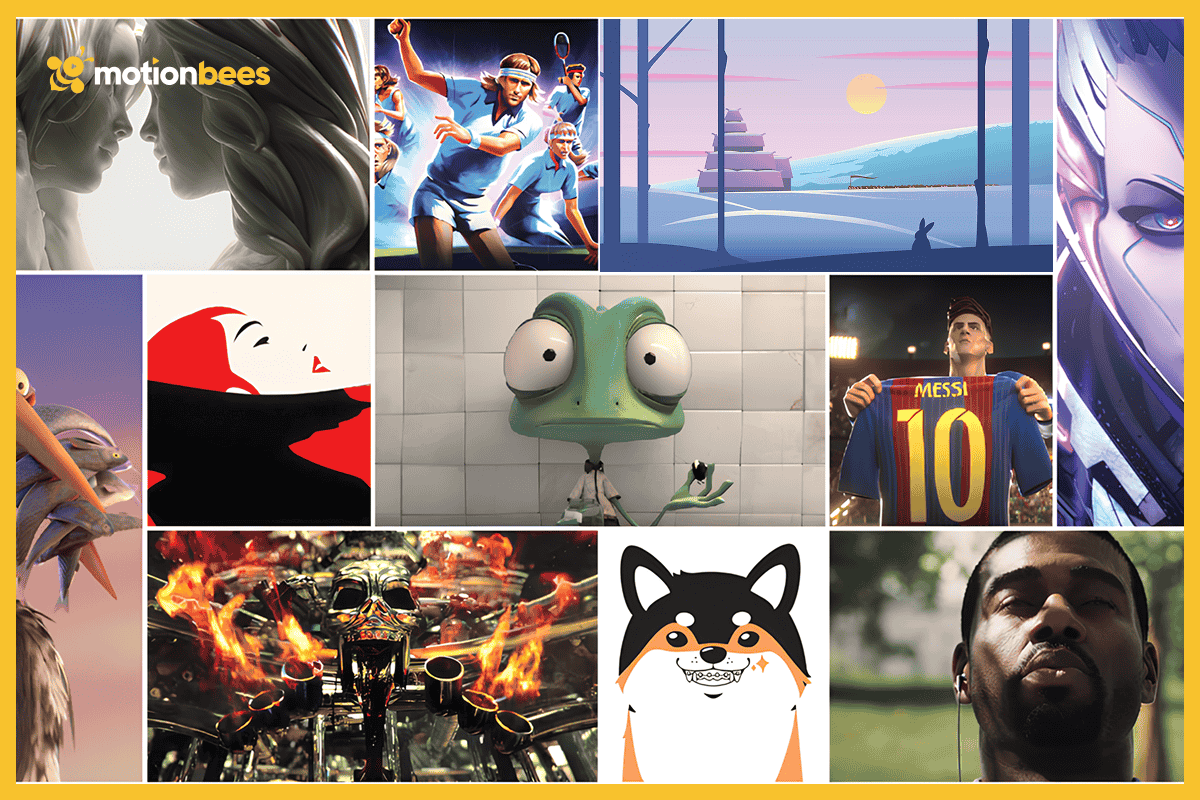
Animations have the power to tell stories, attract, and bring ideas to life. But there is only one key component that makes everything look the same which are style frames.
Wondering what is a style frame? Let’s look at it this way.
To better understand frame style, let’s look at the animation frame definition. In style frames animation, frames are the smallest unit in a moving image. Just like cells combine to make a human body, frames are a single unit that when combined makes a moving image. It is extremely important, just like oxygen to humans and carbon dioxide to plants.
Style frames revolve around the color, lighting, layout, and mood of the moving image. They provide you with a clear understanding of how each of the scenes will appear on the screen. Imagine style frames as the guide to the animation’s visual style.
Whether you are producing motion graphics, a short film, or any creative project, start with the style frames. Style frames are a good way to create expectations early. They also save time, save you from rewrites, and make sure that team members work in alignment.
Simply put, style frames are the key to every animation. Every graphics loving person must know, understand and learn how to make style frames. Learning them will improve the quality of your projects and clearly present your creative vision.
What are Style Frames?
Defining Style Frames
A style frame is a highly detailed representation of a single moment in an animation. In comparison to storyboards, which show motion and activity, style frames show what the moment will look and feel like.
In animation, a frame is a still, which, when played in rapid sequence, produces motion. A style frame puts the stress on one frame to demonstrate the visual style of the entire project.
Ever Wonder Why They Matter?
Style frames let animators and clients see what the finished product will look like. They help select color palettes, lighting, layout, and textures in the early stage of development.
With style frames, you set a consistent brand image. Every team member must align to it. This consistency pays off in the form of beneficial outcomes. According to a report by Lucidpress, maintaining a similar brand appearance across all platforms can increase profits by up to 23%. This is the reason why large organizations invest millions on brand image.
Now, not all firms have access to that many dollars. But Motionbees help you create a good brand image, no matter if your budget is big or small.
Style Frame Examples
One of the style frame examples would be a 2D commercial with multiple style frames. The motion graphics show different characters in different environments. Every frame displays the mood, palette, and appearance. A style frames motion graphics project will utilize frames to experiment with fonts, icons and other dynamic details.
By using style frames, creative teams can make good decisions early and keep the animation visually strong and unified from start to finish.
Style Frames vs Storyboards
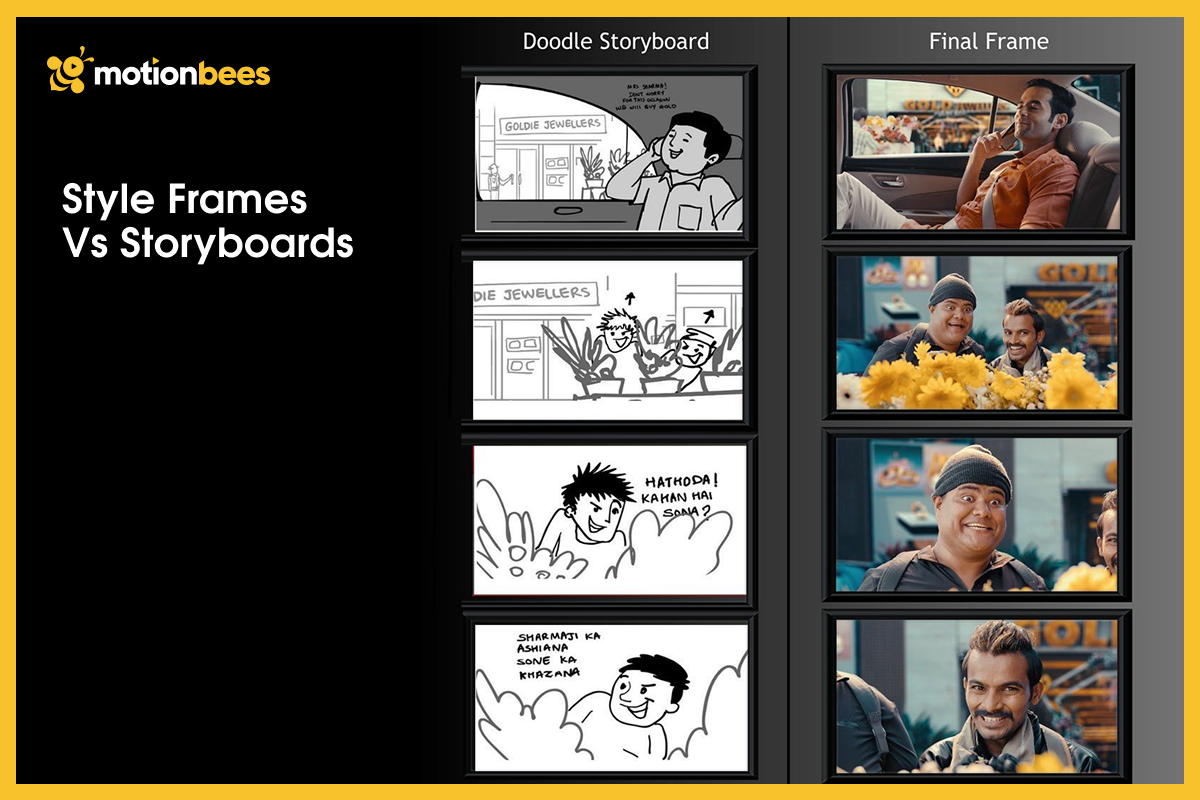
At first look, style frames and storyboards may look similar, but they have different purposes. Storyboards talk about the narrative flow. It provides a series of actions frame after frame that narrate the story in stages.
On the other hand, style frames animation focuses on visual and aesthetic details. In style frame animation, the sequence of events does not matter. Why? Because in frame definition film, style frames present one refined moment with proper light, color and texture.
| Aspects | Style Frames | Storyboards |
| Focus | Single composition | Narrative progression |
| Format | One standalone frame | Multiple frames in a sequence |
| Detailing | Polished and detailed | Simple sketches and outlines |
Imagine This Scene…
Consider a scenario, you are working on the animation of a scene where a character jumps over a fence. Now, the storyboard would display the entire jump step by step in a series of 4 frame animations. Whereas, frame styler will work differently. Frame styler will capture the highlight of the jump with proper focus on lighting, background, and character design. This is how style frames are formed.
This difference helps designers distinguish between storytelling and visual design. Both tools are essential. Using style frames wisely lets you plan and perfect both the story and the visuals efficiently.
The Anatomy of an Effective Style Frame
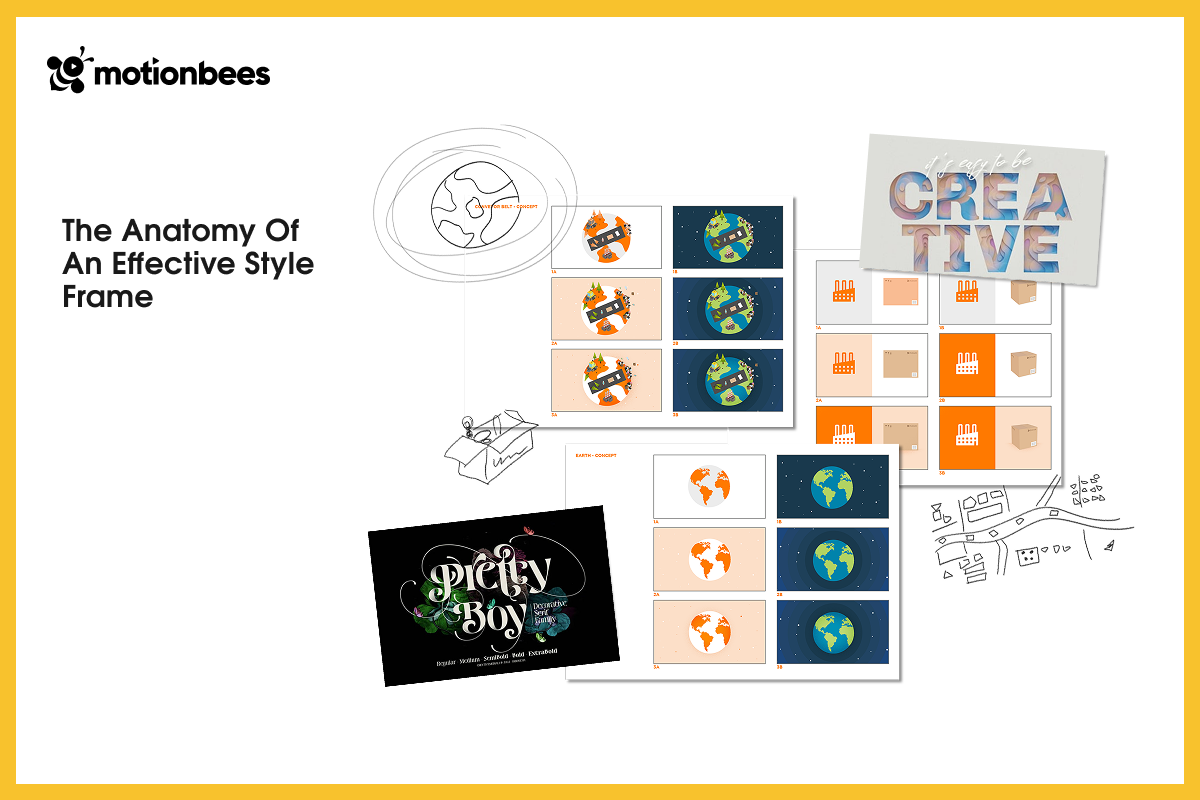
Visual Style Definition
Imagine pausing a film at a point of your liking. One picture is enough to tell you about the light, colors, and feel.
A style frame functions in the same way. The visual style definition talks about how choosing the correct visual style reveals the character of the project. It can be playful, dramatic, smooth, or retro but every style establishes the tone before animation.
Composition and Layout
Each frame style is based on composition. The location of things speaks for themselves. If there is an object in the center, it will look relaxed and at ease. Whereas, off-centered ones create tension. This is why cinematographers and cartoonists study frame examples to understand how composition influences emotions.
Role of Color and Typography
Color matters a lot. A horror trailer may be in high contrasts and dull color, whereas a brand video may be in warm and bright colors. Even fonts matter- typography can be a personality. Whenever the font is handwritten, it is more personal, whereas blocky sans-serifs are the mark of modern professionalism.
Use of Texture and Depth
Adding a texture makes a flat picture look quite real. Imagine film grain versus glittering gradients in online ads. According to frame art definition, details such as texture, depth, lighting must all be a part of a single style. An effective style frame makes sure that the choice is thoughtful and not accidental.
Style Frames in Motion Graphics
Why Motion Designers Use Style Frames
In motion graphics, animation does not begin until the final look is locked in by the animators. It is like trying recipes first. You check if the tastes are fine before showing desire. This simplifies the process of feedback and prevents costly changes in the future.
Connection to Animation
Storyboard design focuses on the sequence but a style frame animation focuses on the appearance. Studies by Wyzowl and Medium indicate that individuals retain approximately 80 percent of what they see, and just about 20 percent of what they read.
It works on the textures, coloring, and tone. According to frame by frame definition, every still frame has personality. And you know what style frame does? style frames give that personality a direction.
Different Kinds of Frames in Animation
Animators work with various tools to deal with different types of frames in animation.
- Keyframes identify big changes, such as a jump or camera move.
- In-betweens buffer the movement.
- Style frames decide how the world looks at the piece.
The modern tools allow you to experiment. With heartful experimentation, you can place different styles examples in front of the customers to decide. And then, the action is taken.
Motion Graphics as Visual Storytelling
Style frames also help in communication. They retain directors, clients and animators at the same wavelength. In their absence, things may be misread. They bring clarity, speed, and a shared vision, which matters in any animation project.
Effective style frames lead to good animations.
Still thinking where to go?
Process of Creating Style Frames
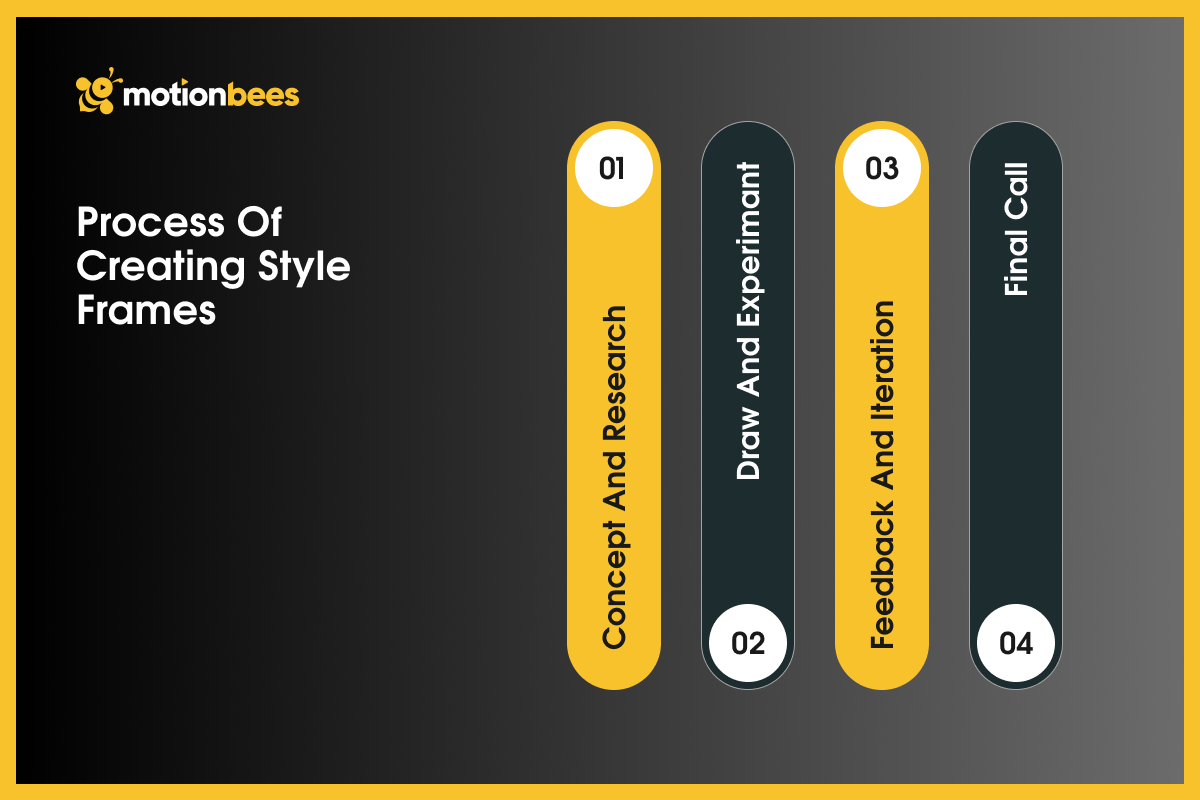
Step 1: Concept and Research
Each movie starts with one frame. If you look at the frame definition in film, that frame is basically the vision of the director.
The same thing happens to style frames where designers learn mood boards, references and preferences of the audience. This is the first step where the goal is to make the tone right.
Step 2: Draw and Experiment
Since artists are creators, they can hardly go with one option. This is why they draw and then experiment.
For example, they will create a series of four frames, each having a different mood. These style frames can be bright and fun, dark and moody, minimal and clean, or bold and graphic.
All the choices are then sent to clients for feedback. Clients compare each frame style before they come up with the best choice.
Step 3: Feedback and Iteration
Sometimes, clients come with the feedback that they need changes. Just like types of frames for paintings changes the look and feel of art, same is the case with style frame variations.
Changes in style frame change the way a story is going to be told. Clients select what rings, and the designer can make it even better.
Step 4: Final Call
The last frame directs the project. It is not just a pretty style of picture frames, but the foundation of animation, branding and marketing.
Similarly, a refined style frame protects the creative vision and stabilizes consistency.
Are you ready to make your ideas come to life? We at Motionbees can make professional style frames that can do the talking.
Applications of Style Frame
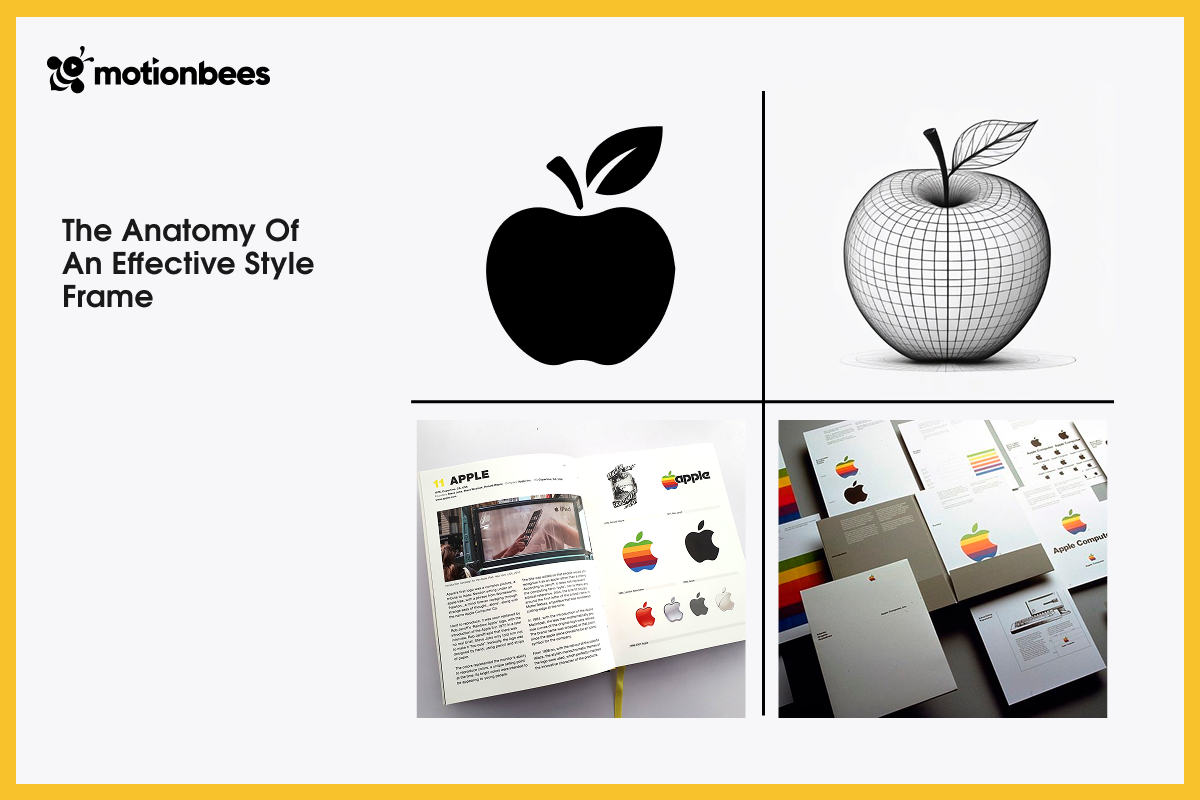
Imagine that during a client meeting you are not just supposed to talk. How else will you explain your vision? That’s when style frame help.
Style frames are like crystal balls because they reveal what the final product will look like. This helps clients and the animators in taking the next step, whether they start making animations or do the changes.
Set the Expectations in Early Stage
For example, in a 2D explainer video, a style frame has cheerful figures, light colors, and amusing typography. Now this will inform the client that the tone will be friendly and informal.
Now, if there is a 3D product demonstration and the style frame shows a bright model of a gadget. The client will expect a clean and professional look.
These are just made-up examples to explain that style frames set the expectations. It shows why it is important for you to deliver style frames being a designing company like Motionbees. If you are on the other side, you can ask for style frames before making any investment in the project.
Practical Examples of Style Frames
Big studios rely on style frames to secure projects and win over the client. An example is Pixar. They use style frames at the beginning of the animation process to establish the mood. This way animators save their time and effort and start only after the green signal from clients.
Other brands like Nike and Apple also request style frames when planning their campaigns. This is because they need to know how the motion graphics will present their product on different platforms.
Beauty of Style Frames
The best thing about style frames is that they can be applied to any kind of artwork. You can make it for an elaborate 2D or 3D model, or a motion picture or any abstract art.
This shows that style frames are versatile. Presenting them or asking for them early in the animation process surely saves time and money.
Tips and Common Pitfalls
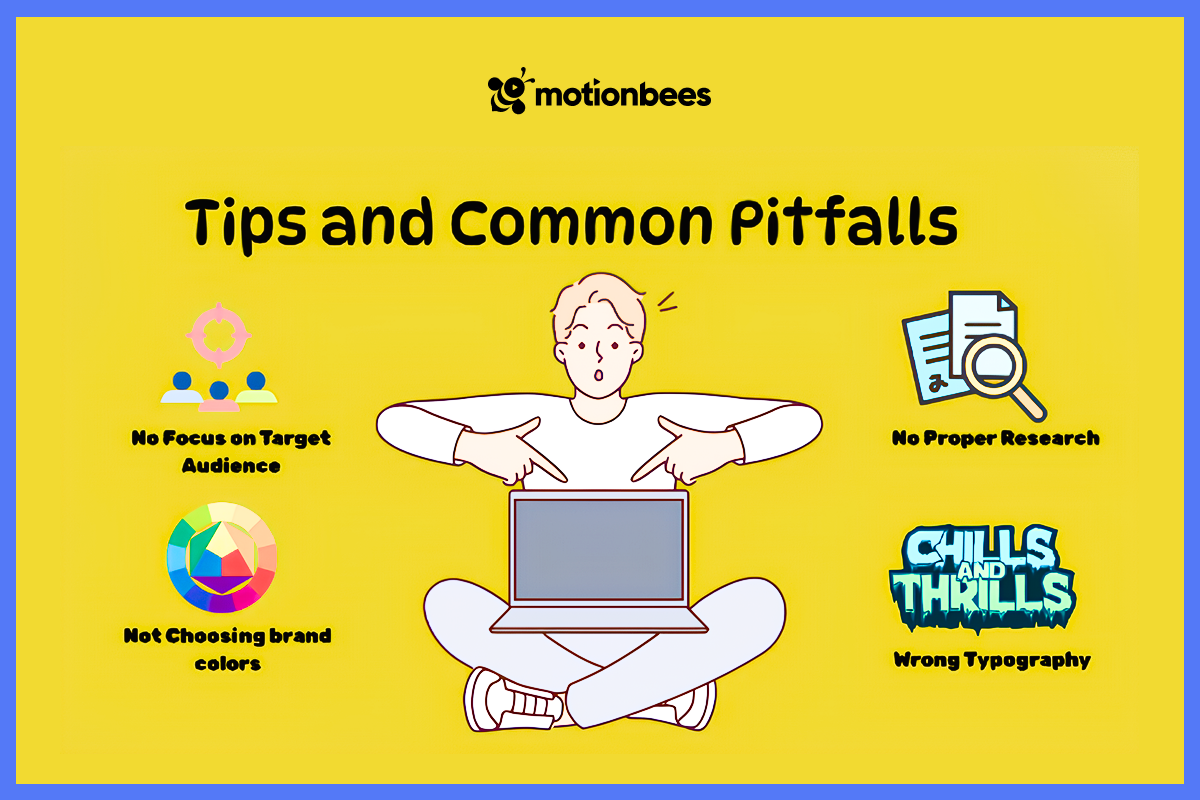
Although style frames are very effective, most creators do face the typical pitfalls.
This includes overloading a frame with details. Style frame are supposed to be clear, not cluttered. The second trap is loss of consistency. When style frames are not connected to each other, then the end animation has a broken look to it.
On the other hand, a competent team will use style frames as a guide rather than a cage. They are flexible towards changes while keeping the approved look. And if you keep the fonts, style, color simple, your design is easily approved.
The best tip? Use style frame as prototypes. Test them, watch feedback, and revise them before mass production. This action will save plenty of backtracking in the future.
Want style frames that are instantly approved by clients?
How Style Frame Influence Final Results?
Many confused style frame with just a pretty picture on the screen. That’s not true! Style frame basically influence the entire production. It preestablishes the tone which saves creators from misalignment and continual rewrites.
Animators already know exactly how the scene is supposed to feel. They know how to assure clients. A professional frame styler makes sure there is consistency so that the whole creative team is on the same page.
Moreover, good style frames also speed up client’s approval. When you take feedback in the start, you gain trust and establish transparency. This transparency reduces production time and enhances productivity.
Finally, style frame work as a guide. It defines how the final work will appear, feel, and move.
Conclusion
Style frames are not placeholders, but storytelling tools. They assist customers in peeking at the future, direct animators exactly where to go, and ensure creative projects flow smoothly.
Whether it’s 2D, 3D, or motion graphics, style frame provide each project with a clear identity.
To creatives, style frames are less about surprises and more about breakthroughs. To the clients, functional style frames build trust and confidence in the process.
FAQs
What is a style frame in animation?
One picture that shows how the complete animation will look in the end is called a style frame. It pre-establishes the mood, color, and design style of the project. Consider it a preview of the final product.
What is the difference between style frame and storyboards?
Storyboards represent the sequence of the actions. Style frame focus on the visual style, colors, fonts, and mood in general. Collectively, they help teams generate perfect stories and the look.
What is the use of style frame in motion graphics?
They present a rich preview of the final look to clients and teams. This cuts the confusion, quickens approvals and ensures the design aligns with the vision. You can get style frames at Motionbees to make your client feel confident upfront.
How many numbers of style frames should I produce on a project?
There are no set numbers. Smaller projects could only require 2 to 3 style frames whereas bigger projects require 5 to 10. The purpose is to give enough options. Not too much to overwhelm the clients.
Is it possible to make style frame in 3D?
Yes! Style frame can be used in 3D and 2D animation. In 3D, they commonly display lighting, textures, and execution style. It also shows customers how realistic the final video will look.
What are the pitfalls in the making of style frame?
The major error includes limited research, too many details, and inconsistency. Too much details can mislead clients and delay feedback. Inconsistency leads to loss of vision. Know that balance is key.
Motionbees manages to avoid these with their extensive knowledge in this field of work. We offer transparent, shiny, and readable style frames with balance between creativity and clarity.
How do I show style frame to the clients?
Show them in context. Take notes regarding color preferences, fonts, and style. This assists clients in understanding why you made the decisions, not what you made. Motionbees simplifies this by taking clients through every step.
Do style fram enhance client communication?
Yes. Visual preview allows the clients to perceive ideas rather than listen to them. It creates trust and reduces forward-and-back changes.
Do I require design software to make style frame?
Yes, but this depends on the project. There is Photoshop, Illustrator or 3D software but creative clarity is the key factor, not the tool.
What impact do style frame have on the end-of-production schedule?
They simplify production. Completion of visuals at an early stage reduces the time spent by the animators’ modifying designs. That accelerates the delivery and prevents surprises.
Looking for style frames to make an impression on the clients?
Lorem ipsum dolor sit amet, consectetur adipiscing elit, sed do eiusmod tempor incididunt ut labore et dolore magna aliqua. ut enim ad minim veniam
